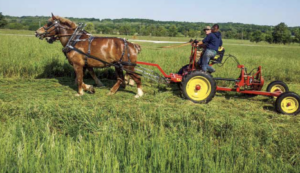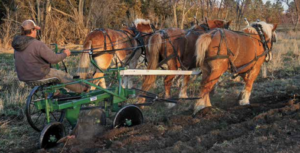Draft Power: The Life-Affirming Alternative to “Big Ag”
Farmers young and old are seeking new ways to shrink their carbon footprint and promote more ecologically friendly ways of getting chores done. So, what’s a modern farmer to do? For some, the centuries old approach of using draft animals—especially horses—is offering a very 21st century solution.
The following is an excerpt from Horse-Powered Farming for the 21st Century by Stephen Leslie. It has been adapted for the web.
The world we have known is vanishing. A new world is hurtling toward us. The consumer culture, with all its fake promises of unending technological fixes to every human problem and need, is crumbling before our eyes. More and more we are asked to face the reality that the biosphere itself is a closed-loop system that requires us to wean ourselves away from energy and power sources that are non-regenerative. Meanwhile, the powers-that-be continue to wage a campaign, plying us with electronic gadgets and pharmaceuticals in an attempt to keep us mesmerized as the multinational corporations fill their coffers extracting every last drop of fossil fuel from the earth’s most fragile and endangered ecosystems.
 Memory and instinct are becoming important to us once again. We hunger to restore diversity to our personal worlds, and we sense the awakening of a fertile desire for more direct contact with our immediate environment. To do this we need to regain the intelligence required to build a human culture that recognizes the sacredness of all life—that experiences the universe itself as a Living Being (what the ancient Hebrews once referred to as a Living God). To do this we need to regain the humility and compassion of a people who know their place within a given landscape. We need to build a society whose foundation stone in every quarter is nothing more or less than the active stewardship of living soil.
Memory and instinct are becoming important to us once again. We hunger to restore diversity to our personal worlds, and we sense the awakening of a fertile desire for more direct contact with our immediate environment. To do this we need to regain the intelligence required to build a human culture that recognizes the sacredness of all life—that experiences the universe itself as a Living Being (what the ancient Hebrews once referred to as a Living God). To do this we need to regain the humility and compassion of a people who know their place within a given landscape. We need to build a society whose foundation stone in every quarter is nothing more or less than the active stewardship of living soil.
In all the major spiritual traditions of our world, discernment has always been recognized as a crucial quality for the seeker of truth. On an elemental level, discernment is what we use to tell the true from the false. Through the practice of discernment, wisdom grows. The farmer, too, must practice discernment on a daily basis; he or she must decide when to sow and when to reap, which one to breed and which to cull. The farmer also faces such choices as: Which tools to employ? On what scale to farm? Just because farming can be done with genetically modified organisms, satellites, robots, and harvesting machines that cost half a million dollars doesn’t mean it should be done that way.
Today there is a grassroots movement of people in our society who are heeding the call to make their living from the land. Increasing numbers of them are also growing intrigued by the concept that many, if not all, tasks requiring traction on the farm can be economically and efficiently accomplished with live animal power. The workhorse is being recognized as an ally that can help us find our way back to a path that leads to life.
When horses, mules, donkeys, or oxen are used in agriculture they become instrumental in enriching the soil because they are a primary source of fertilizer on the farm. In the fields, they tread lightly and do not cause the soil compaction that can result from the wheels and weight of a tractor. The horses are essentially solar-powered: They run on grass, hay, and oats, which they can help us grow and harvest on the farm. By using draft animals to power our farms, we help to minimize our carbon footprint, and they deliver a living, clean, sustainable, and regenerative energy.
Beyond the practical considerations of draft power, entering into partnership with workhorses can also lead us to deeper insight into what it means to be a human being in relationship with the natural world. To accomplish our farmwork successfully with horses, we need to become “a little bit” horse, and the horse needs to become “a little bit” human. Because both human and horse are willing to try, somewhere in the vast gulf that differentiates our species is a space where horse and human can meet and begin to forge a relationship. In many cases, a horse can even become a part of the farm family. We tend to think of farming as the modifications we impose on a landscape to reap our harvests. But there is a relational element that in a very real sense also shapes the farmer. It is like a painter painting a landscape: Somewhere between the interaction and reflection, we are formed and informed.
 When we share work and life with our equine partners, we are simultaneously grounded and elevated. To be effective with draft animals, we need to leave the automated whir of machines behind, slow ourselves down to their pace, and attune ourselves to their unique brand of consciousness. The quality of work done with the horses also lends itself to a heightened sensitivity to the subtle and dynamic qualities of our immediate environment. Rather than placing protec- tive earmuffs on our heads to shut out the roar and din of the tractor, we are invited to open our senses more fully to the experience of the here and now; in fact, staying intimately present is a prerequisite to remaining safe and effective in the tasks we accomplish with our animals. Such attunement is essential to good farming. As those of us with our ears to the ground well know, animal traction technology is not a nostalgic glance backward: Now is a time of exciting new developments for live animal power. As the numbers of adherents of this way of life grows, ecologically minded farmers in their fields are developing efficient horse-drawn systems, and equipment manufacturers in small shops all across North America and Europe are coming forth with new innovations in ground-drive technology that have us poised on the cusp of another agricultural revolution—with working horses, mules, donkeys, and oxen at the heart of it.
When we share work and life with our equine partners, we are simultaneously grounded and elevated. To be effective with draft animals, we need to leave the automated whir of machines behind, slow ourselves down to their pace, and attune ourselves to their unique brand of consciousness. The quality of work done with the horses also lends itself to a heightened sensitivity to the subtle and dynamic qualities of our immediate environment. Rather than placing protec- tive earmuffs on our heads to shut out the roar and din of the tractor, we are invited to open our senses more fully to the experience of the here and now; in fact, staying intimately present is a prerequisite to remaining safe and effective in the tasks we accomplish with our animals. Such attunement is essential to good farming. As those of us with our ears to the ground well know, animal traction technology is not a nostalgic glance backward: Now is a time of exciting new developments for live animal power. As the numbers of adherents of this way of life grows, ecologically minded farmers in their fields are developing efficient horse-drawn systems, and equipment manufacturers in small shops all across North America and Europe are coming forth with new innovations in ground-drive technology that have us poised on the cusp of another agricultural revolution—with working horses, mules, donkeys, and oxen at the heart of it.
